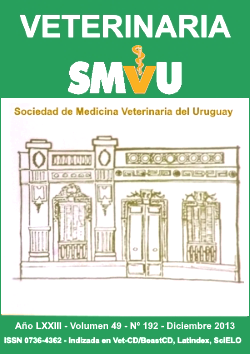Mixosporidiosis branquialis by Henneguya sp. (Myxozoa: Myxobolidae) in Streaked prochilod
Keywords:
Henneguya sp., Gills, Prochilodus lineatus, Uruguay River, De la Plata RiverAbstract
A large number of mixosporidia fish parasites, in which the gender Henneguya has been reported parasitizing shads (Prochilodus lineatus) in Paraná River by many authors in Brazil. The aim of this research was to identify the species of Henneguya in gills of shad in the rivers Uruguay and de la Plata. Furthermore, the prevalence and histological lesions of the parasitosis were established. Eighty one shads were collected, 40 were parasited, representing a prevalence of 49.4%. The presence of the parasites in the gill was observed as small ovoid cysts of 0.5-1 mm of diameter. Inside these cysts myxosporas of Henneguya were recognized, characterized by oval shape, two polar capsules, iodophilic vacuole and a bifurcate caudal process. Their measurements were: 34.80 ± 4.23 µm total length; 14.04 ± 1.96 µm body length; 5.53 ± 0.81 µm body width; 7.25 ± 1.03 µm polar capsule length and 2.79 ± 1.27 µm polar capsule width. At histopathology, plasmodia were located in interlamellar area of secondary gill lamellae, producing a minor alteration and response of the host. The species of Henneguya reported in shads of Paraná River (H. caudalongula, H. paranaensis y Henneguya sp.) have different morphometric characteristics from that those found by us, therefore we postulated that a different species of Henneguya is parasitizing the shad of Uruguay River and De la Plata River. These parasites could be used as biological indicators of shad populations in the Plata Basin.











